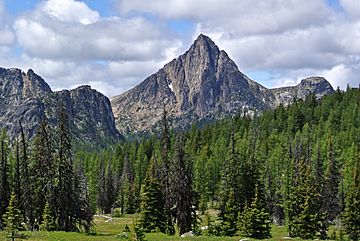Cathedral Peak (Washington) facts for kids
Quick facts for kids Cathedral Peak |
|
|---|---|

Cathedral Peak seen from Apex Pass
|
|
| Highest point | |
| Elevation | 8,606 ft (2,623 m) NAVD 88 |
| Prominence | 989 ft (301 m) |
| Listing | List of Highest Mountain Peaks in Washington |
| Geography | |
| Location |
|
| Parent range | Okanogan Range North Cascades Cascade Range |
| Topo map | USGS Remmel Mountain |
| Type of rock | Granite |
| Climbing | |
| First ascent | 1901 by Carl W. Smith and George O. Smith |
| Easiest route | Scrambling class 3 Southwest slope |
Cathedral Peak is a tall mountain in Washington state. It stands about 8,606 feet (2,623 meters) high. You can find it in Okanogan County. This peak is part of the Okanogan Range, which is a smaller part of the larger North Cascades mountain system.
The mountain is located inside the Pasayten Wilderness. This is a special wild area managed by the Okanogan National Forest. The closest taller mountain is Grimface Mountain, which is about 2.6 miles (4.2 km) north in Canada. The Pacific Northwest Trail is a long hiking path that goes near Cathedral Peak, crossing Cathedral Pass. Another mountain, Amphitheater Mountain, is also close by. Water from Cathedral Peak flows into Cathedral Fork to the west or Cathedral Creek to the east.
Mountain Weather
Most of the weather that affects Cathedral Peak comes from the Pacific Ocean. These weather systems travel northeast towards the Cascade Mountains. When they reach the North Cascades, the mountains force the air to rise. As the air goes higher, it cools down and drops its moisture. This causes a lot of rain or snow to fall on the mountains. This process is called Orographic lift.
Because of this, the western side of the North Cascades gets more rain and snow than the eastern side. This is especially true during the winter months. In winter, the weather is often cloudy. However, in summer, high-pressure systems over the Pacific Ocean usually bring clear skies and sunshine.
How the Mountains Formed
The North Cascades mountains, where Cathedral Peak is located, have very rugged shapes. You can see sharp peaks, tall spires, long ridges, and deep valleys carved by glaciers. These amazing shapes were created by geological events that happened millions of years ago. These events caused big changes in the land's height and led to the different climates we see today.
The Cascade Range started forming millions of years ago, around 50 million years ago. At that time, the North American Plate (a huge piece of Earth's crust) was slowly moving over the Pacific Plate. This movement caused volcanoes to erupt and create new rock. Also, smaller pieces of land, called terranes, crashed into the continent. These crashes helped build up the North Cascades.
Later, during the Pleistocene period (which started over two million years ago), huge sheets of ice called glaciers moved across the land many times. As these glaciers advanced and then melted back, they carved out the landscape. They left behind rock and debris. The "U"-shaped valleys you see in the mountains were formed by these glaciers. The combination of the land pushing upwards (uplift) and cracks in the Earth's crust (faulting), along with the glaciers, created the tall peaks and deep valleys of the North Cascades.
Climbing Adventures
If you're an experienced climber, there are several routes to reach the top of Cathedral Peak:
- South Face - This route is rated class 5.8 and has 7 sections, called pitches. It was first climbed in 1968 by a team led by Fred Beckey.
- Southeast Buttress - This route is rated class 5.9 and has 9 to 10 pitches.
- Northeast Ridge - This route is rated class 5.3 and has 7 pitches.



